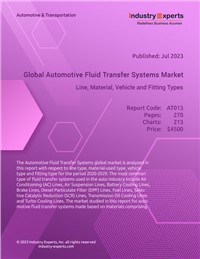Diesel-powered vehicles tend to produce a greater amount of pollutant particulate matter, thereby contributing to a greater extent to environmental degradation. Overcoming this issue can, to a considerable extent, be achieved by using Diesel Particulate Filter (DPF) lines in conjunction with Selective Catalytic Reduction (SCR) technology that can chemically convert harmful diesel-based emissions into regular atmospheric gases, such as nitrogen, oxygen and water vapor. Because of this and also because of a rise in demand for heavy commercial vehicles owing to industrial development across the world, the market for SCR and DPF lines would witness impressive growth over the analysis period. Overall global market for Automotive Fluid Transfer Systems is estimated to be US$22.4 billion in 2023.
Research Findings & Coverage
- Automotive Fluid Transfer Systems global market is analyzed in this report with respect to line type, material-used type, vehicle type and fitting type
- The study analyzes the market size/share for Automotive Fluid Transfer Systems by aforementioned segments in each major geographic region/country
- DPF Regeneration Enables in Enhancing Fuel Consumption and Reducing NOx Emissions
- Electric Vehicle Thermal Management Shifting Towards Oil
- Reduction of Vehicular Exhaust Emissions Being Facilitated by Nanocatalysts
- Adoption of Plastics for Automotive Fuel Lines Charting a Slow, but Steady, Course
- Key business trends focusing on product innovations/developments, M&As, JVs and other recent industry developments
- Major companies profiled – 26
- The industry guide includes the contact details for 71 companies
Product Outline
The report analyzes the market for the following line types of Automotive Fluid Transfer Systems:
- Air Conditioning (AC) Lines
- Air Suspension Lines
- Battery Cooling Lines
- Brake Lines, Diesel Particulate Filter (DPF) Lines
- Fuel Lines
- Selective Catalytic Reduction (SCR) Lines
- Transmission Oil Cooling Lines
- Turbo Cooling Lines
The market for Automotive Fluid Transfer Systems by Material Types used for Line studied in this report include the following:
- Aluminum
- Nylon
- Rubber
- Stainless Steel
- Steel
- Others
The report analyzes the market for Automotive Fluid Transfer Systems by below mentioned Vehicle Types:
- Commercial Vehicles
- Passenger Cars
The study explores the market for Automotive Fluid Transfer Systems by Fitting Types included below:
- OEM Fitting
- Aftermarket Fitting
Analysis Period, Units and Growth Rates
- The report reviews, analyzes and projects the global Automotive Fluid Transfer Systems market for the period 2020-2029 in terms of market value in US$ and the compound annual growth rates (CAGRs) projected from 2022 through 2029
Geographic Coverage
- North America (The United States, Canada and Mexico)
- Europe (France, Germany, Italy, United Kingdom and Rest of Europe)
- Asia-Pacific (China, India, Japan, South Korea and Rest of Asia-Pacific)
- Rest of World



